
 Reaping and sowing the news from an Arab Spring: the politicised interaction between traditional and alternative journalistic practitioners
Reaping and sowing the news from an Arab Spring: the politicised interaction between traditional and alternative journalistic practitioners
Abstract
The ‘Arab Spring’ has been discussed in the mainstream media as a ‘social media revolution’; a seismic shift away from the traditional news correspondence towards an era of citizen journalism and social media reporting. This paper reports on a preliminary analysis of the ways in which mainstream and alternative modes of journalistic practice in particular, interacted during the initial months of protest in Egypt and Libya in 2011. Using both quantitative and qualitative forms of analysis of mainstream news reports as well as social media and blogging, the paper compares the ways in which the two modes of journalistic practice collaborated to disseminate news and information about the protests. The preliminary analysis indicates that productive interactions did occur and led to changes in traditional journalistic practice, though true collaboration was hindered by the organisational constraints posed by the reporting practices of each group.
Introduction
The recent wave of pro-democracy protests in the Middle East, termed the ‘Arab Spring’, has been widely discussed in the media and academia as an example of a shift in the investigation and dissemination of news. This is evidenced by the ways reporters, activists and protesters have utilised digital and social media to share and disseminate information across both alternative and traditional media platforms. While many analyses focus on the ‘disruption’ these tools pose to traditional journalistic practice, or their ‘revolutionary potential’, there is not much discussion of the way in which newer and traditional forms of journalistic practice might have worked together to report on the protests. Thus the Arab Spring protests present an opportunity for new analyses of the changes and tensions that have occurred in the relations between the different forms of reportage. Focussing on six days of protest in Egypt and Libya in 2011, this paper seeks to discuss how interactions between ‘alternative’ and ‘mainstream’ forms of journalistic practice occurred and how they were presented in the discourse of reportage. We have defined interactions as moments where the two modes inform and modify each others’ reportage, including sharing of information, collaborative reportage and discussion of each others’ practice in reportage.
Using both quantitative and qualitative approaches, the analysis shows that alternative and mainstream modes of journalistic practice were productively engaged to share and disseminate news and information to local and global audiences. Both modes of journalistic practice relied on each other at different times to source, confirm and disseminate different forms of information to satisfy their particular vested interests. We will argue that this contributed to a change in traditional modes of journalistic practice; a change which came about because social and digital media were more effective and dominant in disseminating information and combating various communication blocks. However, true 'collaboration' was hindered by the institutional and organisational constraints posed by the discursive reporting practices of each group.
The relationship between mainstream and alternative modes of journalistic practice
This paper will refer to mainstream and alternative ‘modes of journalistic practice’, as opposed to terms like ‘alternative journalism’ or ‘citizen journalism’ which are terms that have come to encapsulate particular genres of journalism. Referring to modes of practice seems to better encapsulate the inherent complexities of the different means of information gathering and dissemination that were occurring during the protests. We also want to avoid making assumptions about who was contributing to news reportage in Egypt and Libya, as well as their institutional, political and personal interests in doing so. We have made these clarifications because the definition of ‘alternative journalism’, as opposed to ‘mainstream’ or ‘traditional’ journalism is a matter of much academic discussion, but no clear definition. Chris Atton (2002: 9) uses ‘alternative media’ as the general term to suggest a practice that provides information and interpretations of the world that would not be found anywhere else. However, Atton and Hamilton (2008: 4) argue that alternative journalism is the ‘journalism of politics and empowerment’, suggesting the political imperative of alternative modes of practice. They also suggest the economic and institutional imperative that alternative journalism is produced ‘outside mainstream media institutions and networks’ and by amateurs ‘who typically have little or no training or professional qualifications as journalists’ (2008: 1). Dissemination of this information occurs via ‘horizontal communication’ networks between members of marginalised or oppressed groups (2008:125). Similarly, John Downing (2001: ix) has suggested alternative journalistic practice as ‘radical’, ‘grassroots’ or ‘community’ media, though these have been forwarded more as a structure of information dissemination and practice not purely focused on journalism. Another popular term used to describe alternative journalistic practices has been ‘citizen’ journalism, linking alternative news practice to forms of citizenship practice and empowerment in the everyday lives of citizens (See Rodriguez, 2001: pp. 20).
One of the more dominant research approaches to describing the relationship between mainstream and alternative journalism has been to analyse the effects of alternative media practice and social media on the traditional structure of ‘professional’ journalism (see Bardoel & Deuze, 2001). These effects are often related to the structure of institutions and economies related to traditional forms of journalism and news media. Heinrich (2011: 51) suggests ‘the news sphere has undergone a shift from a fairly organised, linear news flow structure, to chaotic organisation of information flows produced and disseminated globally by an uncountable number of information transmitters.’ Bruns (2005: 275) calls this a ‘paradigm shift’ towards ‘the collaborative, iterative and user-led production of content by participants in a hybrid user-producer, or produser role’. More broadly, the social repercussions of technological change, such as blogging, citizen journalism and alternative media, have meant that it has been the act of interested individuals or groups, rather than professional journalists, which have allowed for reporting, analysing and disseminating of information on a global scale (Bowman and Willis, 2003: 9).
Other research (Livingstone, 1999; Livingstone & Asmolov, 2010) attempts to understand the effect on the self-representation of professional journalists, as well as journalism as a profession. Thus, the traditional frameworks for study of online mainstream journalism have very much encapsulated the ‘threat’ felt within the industry as a result of shrinking newsrooms and the failure of traditional media business models in a digital age. The rise of user-generated content online has begun to circumvent traditional mass media control of news and information (Livingstone, 1999; Hartley, 2005) and this has even led some to question the concept of needing a ‘professional’ journalist to report news (Berkman and Shumway, 2003). However, others (See Brodin, 2011; Livingstone & Asmolov, 2010) have reinstated the need for trained or professional journalists in an online arena, those who can verify information and must adhere to particular institutional guidelines in order to report. Others (Hartley, 2005) have suggested the ways in which media ethics, laws or regulations will need to change in this era and the ways in which journalists could contribute to this re-working.
While the discussion about alternative journalism has centered on its deviance from mainstream journalism’s economic, institutional and social structures, there are often no clear demarcations around what alternative journalism actually encompasses, and how it differs from other forms of journalism. During the protests in Egypt, for example, there were many people involved in what we might call ‘journalistic practices’: eye-witness reportage of events, analysis of those events in the larger political context, and video, audio and social media updates of information. Some were paid as journalists for Egyptian media outlets, others considered themselves journalists though not paid, some were collaborating with mainstream news organisations and others were defining what they were doing simply as important information dissemination in a time of crisis. Some were even reporting from outside Egypt itself, using online resources to ‘cover’ the protest. Some were not Egyptian citizens but were participating in the reportage of information through other online networks. However, only some of those people identified what they were doing as ‘journalism’ or media production. It is the complexity of this situation that shows ‘alternative journalism’ is an incomplete term to describe the ways in which news reportage may occur outside of the realms of paid journalistic activity.
I define alternative journalistic practices similarly to Rodriguez (2001) as a set of media reportage, production and dissemination practices that are embedded within the everyday lives of people specific to a historical, political and cultural context, though I do not suggest these practices are solely the domain of ‘citizens’. Global online networks allow collaboration beyond the borders of nation-states and citizen identification. Instead, alternative journalistic practices demarcate themselves from professionalized and institutionalized practices of the mainstream media in their focus on a particular audience, issue or specific context. In serving those interests, alternative journalistic practices emphasise overt advocacy, first person and eyewitness accounts, collective organisation and reporting practice and populist styles of presentation (see Rodriguez, 2001). This is a demarcation from the professionalised practices of mainstream journalism which operate according to particular professional and discursive codes of practice, as well as a particular economic model. Their economic imperative means that mainstream media are disseminated via the largest distribution channels and are likely to be encountered by a larger number of consumers.
These demarcations are not to suggest an either/or distinction between alternative and mainstream reportage practices. Following John Downing (2001), we would suggest that a continuum of journalistic practices exists ranging from the person who simply uploads video content onto YouTube through to the professionalised practices of investigative journalism. This demarcation separates the types of journalistic practice evident during the Arab Spring protests, but also attempts to acknowledge that a power relation exists between types of media production and distribution despite their various interactions. Harcup (2001:361) also suggests that the institutional cross over between alternative and mainstream practitioners working in both spheres means that some complexities arise in this perception. Harcup (2001:362) refers to Downing when he suggests that there has been a realisation that alternative and mainstream media are not binary opposites.
Downing (2001: ix) has suggested that there has been a tendency in the field to assume a dichotomy between mainstream and alternative journalistic practices, without considering the relationship between them. He suggests instead that ‘the edges are almost always blurred’ between the demarcation of alternative and mainstream journalistic practices and functions. Thus, while earlier research suggests that alternative journalistic practice threatens mainstream journalism practice, more contemporary research has shifted to thinking about the level of interaction between the two forms of journalism.
Methodology
The goal of the analysis was to find the ways in which alternative and mainstream journalistic practice interacted and the kinds of discourses these interactions created. The analysis was framed by two research questions: how did mainstream and alternative journalism practitioners refer to each other in reportage during the Egyptian protests? Secondly, what were the dominant themes or discourses that emerged as a result of the interaction between mainstream and alternative journalistic practice during the Egyptian protests? To answer these questions, we developed a mix of quantitative and qualitative analytical approaches, counting the ways in which interactions were made across alternative and traditional modes of journalistic practice, as well as a thematic analysis of the kinds of discourses arising from those interactions.
The thematic analysis follows Orbe and Kinefuchi (2008) in utilising three criteria to elicit emergent themes from diverse communication sources. The first of these three criteria are repetition, which is the preliminary form of analysis that searches for words or phrases that appear frequently. Second, we looked for recurrence, which examines how these repeated terms contribute towards a shared meaning or discourse. The different meanings reveal the complex process where individuals or groups negotiate facts and opinions to reach some form of consensus or divergence around a discourse. Third, we looked for forcefulness, which was the particular tendencies towards emphasis of certain discourses over others and the ways in which this emphasis was expressed. This analytical process allows for a systematic qualitative analysis, even where there is no consistency or agreement amongst the various texts chosen for analysis. This is important given the variety of materials elected for analysis and the different societal, political and cultural roles of both the communication technologies and their users. The individual analyses were reviewed together to compare how the emergent themes occurred across the differing protests, as well as the different media and practitioners.
Materials for analysis were selected from four online sources: Twitter, and personal blogs, as well as three mainstream news organisation's websites: CNN, BBC and Al Jazeera. Text, audio and video material were selected for analysis from these sources. Specific dates were chosen to frame the analysis firstly, because of the ongoing nature of the political situations in Egypt and Libya, and secondly, to gain a stable selection of data for analysis and comparison. The dates were chosen according to either their political significance or whether journalistic practice may have been impacted by the events of the protests. That is, we chose days where journalistic practice may have been ‘hindered’ by government or military sanction or violence against journalists, communications interruptions or curfews and compared these days to days which were politically significant, but not hindered in the same way.
For the selection of tweets for analysis, a social media archive application called Topsy was used to search for tweets on particular dates. The Tweets were collected according to hashtags, in particular #Jan25, #Libya and #Egypt. This was an initial step – finding the most popular tweeters according to number of tweets posted, number of times re-tweeted and number of followers was the second aspect of gaining materials for analysis. The selection of blogs was based on recurrence of messages and blog posts over time, as well as popularity of the blogger. Recurrence was measured according to how many posts or messages were posted on the site and the amount of commentary each post or message garnered.
The analysis of the two forms of online journalistic practice was completed in several stages. The first part of the analysis was aimed at searching for repetition, which is the preliminary form of thematic analysis. This included interactions in the form of linking, footnoting, Twitter, Facebook, YouTube videos and excerpts from blogs in reportage. We completed a manual search for words or phrases that appeared frequently in separate news outlets, as well as tracing what platforms were being used to report. We were searching for their recurrence to examine in the next stage of the analysis how these repeated terms might contribute towards a shared meaning or discourse. A reference was only counted once per article because we were looking for recurrences across the articles rather than within individual reports. This ensured significance of the way a particular reference or meaning was shared across reports was not unfairly skewed. For example if the word ‘protestor’ appeared 10 times in an article, it only counted as one reference, though a note was made of its importance in a particular article.
The analysis of mainstream and alternative journalistic practitioners’ discursive interactions illustrated that traditional journalistic practice has been influenced by the changes brought by digital media technologies, social media and alternative journalistic practitioners themselves. Both mainstream and alternative journalistic modes of practice assisted each other to source, confirm and disseminate information to both local and global audiences.
Analysis of interactions between mainstream and alternative modes of journalistic practice
We refer firstly to the initial analysis of the Egyptian protests. Three ‘unhindered’ days were chosen for analysis. The first day chosen was January 26; it was significant as one of the first days of mass protests with a serious escalation of violence, though at this early stage of the protests many of the mainstream reporters had unfettered access to witnesses in order to compile reports. The second day chosen was January 31, 2001; it was significant because protesters held ‘The March of the Millions’. This was a planned protest of over a million people in Tahrir Square. This is also the first time news organisations begin referring to the “April 6 movement ‘ as the grouping of protesters involved in the activism around Tahrir Square – in particular the call for the march of millions. The last day chosen was February 7, 2011. It was politically significant because it was the first real indication that Mubarak’s regime was slipping; indeed, on this day he agreed to make changes to the constitution. Three ‘hindered’ days were chosen for analysis. The first day chosen was January 27, 2011, a day punctuated by constant stoppages of internet and phone connection, reportedly by Egyptian government officials. The second day chosen for analysis was January 28, 2011. This was a particularly significant day as the ‘Friday of Rage’ protests began. Egyptian authorities also shut down most communication services to disrupt organisation of the protests online and through mobile phones on this day. The third day chosen for analysis was February 3, 2011. This was a particularly dangerous day for journalists to be on the street as gunmen were reportedly firing on anti-government protesters in Cairo. The first phase of the analysis looked for repetitions of particular references in mainstream forms of journalistic practice on hindered and unhindered days. In particular, we looked for:
- References to ‘protestors’, ‘demonstrators’, ‘witnesses’ or ‘activists’ to decipher how and when reportage was referring to participants or witnesses to protests in different ways;
- References to different witness accounts as a way of searching for the different people that journalistic practitioners were sourcing information from;
- References to social media or communications blocks as a way of examining how journalistic practitioners were referring to social media use in reportage;
- References to social media use during the protests as a way of registering how particular journalistic practitioners were using social media in their reportage; and finally,
- References to historical, political or governmental context to identify the kinds of information or context a particular journalistic practitioner was forwarding as ‘important’.
The Graphs 1 and 2 represent how the references were repeated across the different media:
Graph 1: Repeated discursive references on hindered days (Egypt)
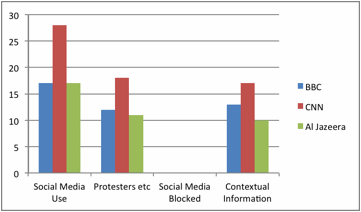
Graph 2 Repeated discursive references on unhindered days (Egypt)
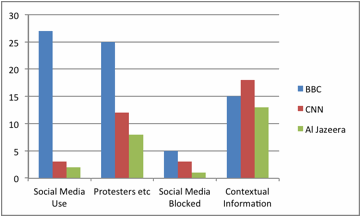
Looking firstly at the kinds of discursive references made, a number of patterns emerge. On ‘hindered days’ (Graph 1), mainstream reportage contains many more opinion features and contextual reportage, perhaps reflecting the disruption to reportage that had occurred in previous days with internet and phone services repeatedly cut by Egyptian authorities. For example, approximately seven long-form opinion-based or contextual articles were published online for CNN on the 31st January. This included blog posts and traditional format articles. CNN also employs mainstream journalism bloggers who write with a less formal voice, more opinion and provide a lot more contextual information. For example, CNN business anchor, John Defterios, wrote a business blog contextualising the Egyptian protests in the economic and political climate. On another day of hindered reportage, February 7, all of the major mainstream news corporations decided to publish contextual timelines of events. Some of the events are sourced from Twitter hashtags and Facebook centred events, such as the release of Wael Ghonin.
Ironically, it is on the unhindered days in Egypt (Graph 2) that many more discursive references to social media blocks occur. This can be explained by journalists having more access to local witnesses who are concerned about the access to communications. Nonetheless, reliance on social media in mainstream journalistic practice is immediately noticeable in the constant reportage of communication blocks. Many individual reports (Twitter blocked, 2011) refer to the fact that Twitter had been blocked, which is perhaps demonstrative of just how important the service was and how useful it had been to both alternative and mainstream journalistic practitioners. One article reported that an Egyptian journalist, Sarah El Sirgany, twittered the news from her phone all day after the Daily News Egypt website was shut down (Get to know, 2011). Another confirms Twitter’s assertion that it had been ‘shuttered by Egyptian authorities’ (Twitter blocked, 2011). This continues on January 28 whereboth CNN and BBC mention that internet and mobile phone signals have been interrupted and that riot police have been deployed on the street, making it somewhat dangerous to report (Holmes, 2011; Egyptian-American, 2011). Another CNN feature, ‘Social media @ the front line in Egypt’ (Lister, 2011), reports on the relationship journalists and demonstrators have had during the protests (Lister, 2011). It takes issue with the amount of hyperbole social media sometimes creates, but also talks about the assistance that the tools such as Twitter cab provide (Lister, 2011).
Lastly, we examined more closely the types of sources and source material that were being used in reportage.
Graph 3: Social media sources used on unhindered days (Egypt)
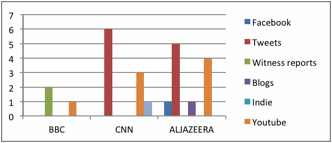
Graph 4: Quoted sources in media on unhindered days (Egypt)
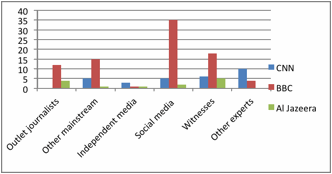
Graph 5: Social media sources used on hindered days (Egypt)
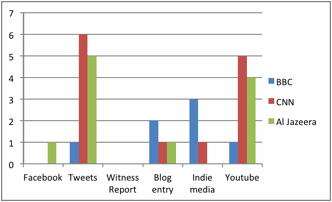
Graph 6: Quoted sources in media on hindered days (Egypt)
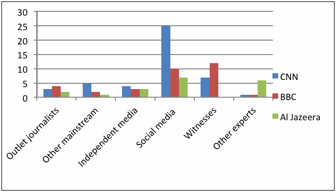
Looking at the ways in which reportage was sourced, in mainstream coverage of the Egyptian protests, there was a mix of traditional reporting techniques being used in the coverage (i.e. reliance on reports from correspondents on location to ‘break’ the news) as well as social media/citizen journalism techniques, whereby the news was sourced from Twitter, Facebook and other social media platforms, and from posts by a broad range of contributors including, official media representatives, ‘citizen journalists’, activists and NGOs. These contributions were often subsequently aggregated into a format that enabled listeners or viewers to access a broad overview of the developing situation.
On the three days where reportage was unhindered (Graphs 3 and 4), the number of sources of information that journalistic practitioners refer to jumped in number. The analysis shows a number of official and non-official sources being used in the longer reports; in fact the sources of information were quite plentiful for mainstream journalists. For example, in the course of one CNN article (Egyptian police crackdown, 2011) both official governmental sources and unofficial witness reports were used quite prodigiously to inform reportage. In just one report the journalist is able to source information from: Egypt’s official MENA news agency; the main opposition party the Muslim Brotherhood; State-run Nile News; Egypt’s Interior Ministry spokesman; the US State department; the Egyptian Embassy in Washington; the US secretary of state Hilary Clinton; the Jordanian Foreign Minister Nassar Judeh; journalists from the Committee to Protect Journalists; human rights organisation The Arabic Network for Human Rights Information; citizens on Twitter, as well as those participating in protests. On January 26 some mainstream reports refer to information sourced from talking to witnesses and protesters first hand. Other reporters refer to information that they had been monitoring on Twitter.
On the three hindered days (Graphs 5 and 6), the ability to source information becomes more complex. The number of sources available to journalists appears to drop in number. On January 28 it appears that BBC has a more active journalist in Cairo who is able to get comments from local journalists on the ground. It also appears that BBC has much more information from people at Tahrir Square, and uses information from social media more readily. One report about the ‘Friday of Rage’ protests shows YouTube footage posted on social media websites without a source or verification materials–though it does use the words ‘purports to show’ in its description of the footage (Cairo protests, 2011). Another article features the prominent activist and blogger Gigi Ibrahim as an expert (Egypt unrest, 2011) and also provides a video of her interview. Another ‘eyewitness’ is given prominence in a video about the planned ‘Friday of Rage’ protests (Cairo protests, 2011). It appears that protesters and locals are being given a lot more space to talk about what they see as a result of the internet shortages.
Al Jazeera appears to be slightly more enamoured of social media than other organisations. Al Jazeera also contextualises the use of social networks in the protests not as reportage or information, but as the rallying of protesters. One reporter suggested:
After having their Cairo bureau closed and press credentials revoked by Egyptian authorities, Al Jazeera journalists continued to tweet and call in anonymously to report on the protests to the news organization’s live stream. Al Jazeera Englishand other news organizations like Russia Today utilized YouTube to post updated video reports on the demonstrations’ (Lavrusik, 2011). Social media was also vital in allowing news organisations to interview protesters from remote locations, as was the case with The New York Times interview with Gigi Ibrahim, conducted via Skype (Mackey, 2011).
It appears, however, that most of the organisations relied more heavily on social media on hindered days.
Completing the analysis on news reportage in Libya was much more difficult to analyse. The dates chosen for the unhindered analysis were: February 17, the ‘Day of Rage’, where 14 Libyans protesters were killed in clashes with pro-government forces. Secondly, February 20, where reports that African mercenaries had been brought in by the government to kill Libyan protesters. Lastly February 22, where then-President Gaddafi makes a rare media appearance confirming that he is still in Libya. There are only three days of analysis because reportage was incomplete or so small on the initial days of the protests that an adequate data sample could not be garnered.
The volume of reportage and the discourses varied so much, that it was difficult to draw together a coherent range of discursive references. There were also serious institutional constraints that affected the analysis. For example, CNN did not have media access to Libya at the beginning of the protests. Journalist Ben Wedeman was only allowed access into Libya as of February 21. Al Jazeera was also singled out as a dissident Arab channel and was not permitted entry into Libya, which explains the very small number of reports to analyse and the huge reliance on eyewitness reports as we shall go on to see. Al Jazeera stated that:
[v]erifying news from Libya has been difficult since the protests began, because of restrictions on journalists entering the country, as well as internet and mobile phone blackouts imposed by the government (Uprising flares, 2011).
In addition there was the problem that such sourced material could not be verified which made it difficult for mainstream journalists to confirm most of the news. What we can show however, is the absolute reliance reporters had on social media and media-savvy witnesses to help them to report on the situation. Witnesses, activists and alternative journalistic practitioners were almost exclusively painting the scene for mainstream journalists.
Social media also provided an alternative technique of news-gathering when it was too dangerous or technically difficult for correspondents to remain on location. For example, Mashable (Lavrusik, 2011) also describes the blogs and ‘curated’ Twitter, YouTube and Facebook posts which were a part of the mainstream coverage of the uprisings in Egypt and Libya, and sometimes the only coverage, particularly during the state crackdown on journalists in Egypt and for the early days of the Libyan revolution. In fact, the Al Jazeera live blog covering the Libyan revolution went as far as crediting Libya 17 voices as a main source of news reportage during the early days of the conflict. They also established a permanent link on their site to a live-stream set up by a protester in Benghazi. This is indicated in graphs 7 and 8:
Graph 7: Quoted sources in media on unhindered days (Libya)
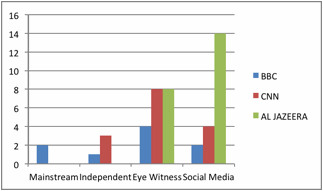
Graph 8: Use of social media and activist sourced material on unhindered days (Libya)
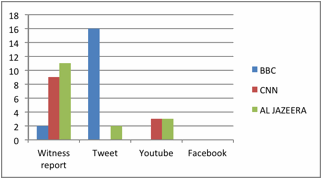
Graph 9: Quoted sources in media on hindered days (Libya)
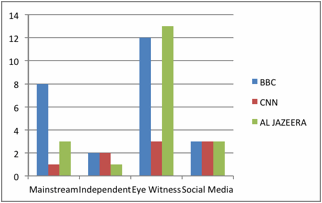
Graph 10: Use of social media and activist sourced material on unhindered days (Libya)
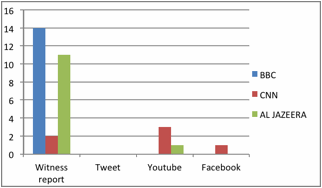
Given the constraints of reportage in Libya and the extreme communications blocks, news organisations were sourcing much of their information from social media. For example, BBC were sourcing information from what they termed ‘dissident websites’ and from three main tweeters: ‘Feb 17 voices?’, ‘shabablibya’ and ‘enoughgaddafi’, though information was presented as unverified. CNN also relied on social media and websites, though they were able to rely much more on eyewitnesses in the street, given the exclusive access given to journalist Ben Wedemen. For example, CNN uses a ‘medical source’ who reported deaths during the protests (Get to know, 2011) and activist sources who reported on the number of protests occurring (Get to know, 2011). In these examples, the organisation uses these sources of information without naming them specifically due to the dangers associated with the protest situation.
Alternative modes of journalistic practice in Egypt and Libya
Given the dominance of social media in both the Egyptian and Libyan protests, we also analysed the ways in which alternative modes of journalistic practice emerged. There was also no discernable difference in the number and types of source material used in these alternative modes of journalistic practice on hindered and unhindered days. We assume this is because of the larger numbers of people involved in these practices and their ability to network information across a variety of platforms. Furthermore, communication blocks were effectively managed by networks of activists and reporters, either by re-routing servers, using traditional word of mouth networks and even compelling mainstream media reporters to disseminate information.
The differences in reporting styles between alternative and mainstreams modes of journalistic practice were noted first. While mainstream modes of practice were attempting to maintain a professionally distant and objective discursive style, alternative modes of journalistic practice were much more subjective, first person accounts. For example, Egyptian activist Mahmoud Salem writes in his blog ‘Rantings of a Sandmonkey’, about his own experiences of the protests. On February 3, he writes a moving report of his experiences of fatigue after being on the protest frontline, and moving between friends’ houses to rest and avoid police.
We were being collectively punished for daring to say that we deserve democracy and rights, and to keep it up, they withdrew the police, and then sent them out dressed as civilians to terrorize our neighborhoods. I was shot at twice that day, one of which with a semi-automatic by a dude in a car that we the people took joy in pummeling (Salem, 2011).
He was arrested and assaulted on the day the post was written and his account widely reported in mainstream media.
Both tweets and blogs that were analysed for the Libyan and Egyptian protests were noted for their 'dramatic' reporting style and their emphasis on description. Interestingly, social media reports also appear at times to be more joyous, humorous and celebratory in their representation of what they consider to be a ‘youth' revolution. For example, Mosaaberizing a photographer who lived in Tahrir square during protests tweeted: ‘I kid you not. A group of us are practicing baseball with the stones they’re throwing. Bats and all. Fun revolution :).’ Obviously, much of the description and audio-visual components are not professionally produced, unedited and uncensored, providing much more of a lived experience of the protests.
The blogs were a version of long form storytelling and appeared to be both informational and descriptive in their own right, but also assisted in confirming mainstream modes of journalistic practice and were often quoted directly in mainstream modes of journalistic practice. It appears that especially for those bloggers that collaborated closely with mainstream news organisations, the aim of the blog was to inform but also to change the narrative and discourses used by western media organisations. For example, the Egyptian blogger Zeinobia (2011) writing in the blog ‘The Egyptian chronicles criticises Egyptian media’, who Zeinobia suggests have sided with the government against the protesters. She reports instead that popular talk shows on Egyptian TV, such as Mona El-Shazly’s show, is removing anti-Mubarak chants from video footage of protests (Zenobia, 2011). Similarly, Issandr el Amrani, who writes for the blog ‘The Arabist’, recommends in his post ‘Stay cool and read Jonathon Wright’, that readers also follow his friend, a fellow journalist, and recommends his blog for a “level-headed ‘ analysis of what is happening in Cairo (el Amrani, 2011).
Whilst there are several blogs that cover the Egyptian uprising, there is a clear absence of highly visible blogs about the Libyan revolution. I assume this is because of the comparative lack of media freedom and personal expression in Libya. This meant that Twitter was the best resource for reporting from inside Libya, even though Facebook was used to mobilise the movement. Forms of reportage on Twitter seemed to have four different characteristics. The first type of tweet was mainly descriptive of events that had occurred directly to the tweeter or they had directly witnessed. This was an important form of information dissemination, widely utilised by mainstream modes of journalistic practice. For example, Shabablibya (2011) tweeted: ‘#Benghazi protesters burnt down the radio station and taken the media and will make announcements shortly!! BREAKING URGENT #Libya’. This tweet was then utilised in reportage in Al Jazeera’s news blogs (Live blog, 2011). The second form of tweet confirmed or re-tweeted what had been reported in mainstream media organisations with or without additional commentary. For example, lyad_elbaghdadi (2011) tweeted: ‘Confirmation on #Aljazeera now that African mercenaries did break homes in #Benghazi and raped Libyan women’ with a reference to an Al Jazeera report. The third type of tweet commented directly on communication blocks, such as the broadcasting channel Ustream who tweeted that Twitter was blocked in Egypt. Ustream also continually provided information about communication blocks and facilitated a live feed of the protests on the streets of Cairo. The last type of tweet confirmed reports by other protesters through re-tweet or further evidence. For example, Habibh (who is also a well-known entrepreneur and activist) tweeted: ‘Egypt gets its Tiananmen square moment. Man bravely stands in front of armoured vehicle! Must watch!’ (2011). This tweet was also widely reported verbatim in the mainstream press and the amateur footage from YouTube was linked to.
The second part of the analysis found that both mainstream and alternative journalistic modes of practice interacted in different ways to source, confirm and disseminate information to both local and global audiences. What these forms of interaction show are that changes in the traditional practices of journalism were occurring in order to investigate and disseminate news and information in difficult communications environments. We now bring the two forms of analysis together to think about the changes and tensions that occurred during particular interactions between mainstream and alternative forms of journalistic practice. In this broader qualitative analysis, we found that these interactions were both co-operative in disseminating information, and in the amount of direct reportage that alternative modes of journalistic practice were allowed in mainstream news reports.
Firstly individual bloggers conveyed information to their readers using links to mainstream news coverage. In addition twitter users frequently re-tweeted coverage from the mainstream press, occasionally criticizing the coverage, but in the main using it as a source of credible information. However, a change we noted in the analysis was that mainstream modes of journalistic practice were also using more social media as a major aspect of their investigation and reportage, especially tweets and YouTube footage. Several journalists used Twitter to supplement their investigations, such as a journalist from the BBC who tweeted in Libya on February 15 (2011): ‘BBC WS wants to speak with anyone in #Benghazi #Libya at the moment, pls email me bard.aune@bbe.co.uk or call +44 207 557 3714’. Other supplemented their own reportage with their personal views, such as Anderson Cooper from CNN who tweeted ‘Situation on ground in #egypt Very tense. Vehicle I was in attacked. My window smashed. All ok.’ Similarly, BenCNN (2011) tweeted: ‘Wave of attacks against journalists motivated by State media, gov't. claims of a ‘foreign hand’ in #Jan25 uprising.’
The second major change we saw was the direct reportage into mainstream news reports that alternative modes of journalistic practice were allowed. In particular, some major news stories were actually broken by activists calling into mainstream news organisations to report facts, clear up misinformation, and also call for international help. This was an exchange that was encouraged and promoted during the protests in both Libya and Egypt as it also assisted in information gathering for mainstream journalists. For example, Al Jazeera allows a ‘celebrity’ protester, Alaa al-Aswany , author of a best-selling book in Egypt which portrays the country’s corrupt politicians and police brutality, to report on the protests in his own words (Fresh anti-govt, 2011). Another article on the BBC features the prominent activist and blogger Gigi Ibrahim as an expert (Egypt unrest, 2011) and also provides a video of her interview. Another ‘eyewitness’ is given prominence in a video about the planned Friday of Rage protests (Cairo protests, 2011). Similarly, the major news organisations cooperated with activists to assist on the dissemination of news and information. For example, The Arab Forum describes Al Jazeera’s process in Egypt:
When Al Jazeera’s signal was cut by authorities in the country, and the network’s journalists were forced to hide their identities whilst reporting, it became a case of demonstrators calling up news channels to report as well. During the first few days of protests, when the Egyptian government cut the internet to the whole country, residents were speaking to friends abroad via landline, and in turn those friends would share information via Facebook, Twitter etc (MacArthur, 2011).
In collaborating closely with mainstream news organisations, one of the aims of the alternative modes of journalistic practice was to influence the discourses used by western media organisations. In Egypt especially, activists such as Gigi Ibrahim, Wael Ghonim and others are quoted directly in the mainstream press, and their representations of events on the ground are then ‘recycled’ through other news channels. This is evidenced in some accounts where activists correct mainstream journalists who refer to ‘pro-Mubarak demonstrators’. Instead activists and bloggers used the term ‘thugs’, implying they are not sincere supporters of the regime, but hired henchmen. This representation became widely quoted in the mainstream media, especially in Al Jazeera who stopped referring to ‘protesters’ in favour of the description ‘pro-democracy protesters’. This was in opposition to BBC and CNN who began their reportage referring to the more negative sounding “anti government protesters ‘, but later changed in line with Al Jazeera.
Reaping and sowing different forms of news during the Arab Spring
Social media coverage of the Egyptian and Libyan uprisings thus demonstrated a high level of cooperation and interaction between different forms of journalistic practice to satisfy the different vested interests of each group. The Arab Media Forum (MacArthur, 2011) describes this participation for vested interest as a process of cooperation:
When internet coverage was blocked twenty-four-hour news channel Al Jazeera – a news outlet using the old media platform of T.V– curated and collected the raw, immediate content citizens were sharing from each and every country, and made all that content available to television viewers as fast as possible. According to the Allied Media Corporation, Al Jazeera reaches 40 million viewers in the Arab world. Their extensive coverage of the Arab Revolution and willingness to broadcast both original citizen journalism and diverse views allowed Arab citizens without computers to see the digital content being shared by their neighbours and countrymen (MacArthur, 2011).
What then are the sources of tension in these largely cooperative and productive interactions? The larger thematic analysis found that the true collaboration was hindered by the particular vested interests of each mode of journalistic practice. The dominant nature of the alternative modes of journalistic practice seemed to create a communications and media environment all of its own. This meant that any changes in journalistic practice that were occurring were independent of other forms of reportage. It also changes the way in which reportage is used. For example, during the Libyan protests, much of the social media reportage was used as a method of communication between activists, protesters and locals. Tripolitanian (2011) in Libya tweeted: ‘#Benghazi hospital has run out of anesthesia a day ago, have to perform surgery without painkillers, please send supplies’. Similar tweets in Egypt gave information and helped to organise protests. Organizers of the protests used Facebook and Twitter to mobilise protesters and then as an ‘amplifying’ tool to spread news in real time, such as where security was heading and where help was needed direct to people’s mobile phones.
The discourses coming out of alternative modes of journalistic practice did not serve to confirm or inform mainstream journalistic practice, but to create a communications and media environment all of its own. Thus the media that were meant generally to inform protesters and activists also conveyed news and awareness in the international community because mainstream media was facilitating further distribution of these online and social media messages. Protesters were also well aware of this process, often directing tweets to ensure that major news organisations were covering parts of the crisis that activists had a vested interest in amplifying coverage of. For example in Libya, Shabablibya (2011) tweeted ‘@AJELive @AJEnglish #Libya #feb17 Benghazi is calling on you! Cover the protests!’
Whilst all this might paint a picture of the mainstream press appropriating social media in a way which continues its domination of the media landscape (particularly as it doesn’t always credit ‘citizen journalists’ for the work they have done) this account is challenged by Natasha Tynes, director of the International Centre for Journalists’ Middle Eastern programs, specializing in online journalism. As she tells Egypt Today:
[M]any mainstream media outlets were caught off guard as they realized that citizen journalists were filling major holes found in the coverage of professional journalists (Rabie, 2011).
Tynes argues that the two forms of media both complemented one another, and corroborated with one another to provide international coverage during media blackouts and journalist/protester arrests:
During the internet outage from January 28 to February 2, people tuned in to mainstream media such as TV news channels. Afterward, during the crackdown on journalists that began on February 2, mainstream news outlets relied on online activists, with tweets and emails frequently quoted in articles and live blogs (Rabie, 2011).
Mainstream media, therefore, had to rely on social media in the coverage of the protests and in turn social media played a role in the way information was reported and disseminated within mainstream journalistic practice. Whereas alternative practitioners embraced the information dissemination possibilities of new technologies (and were also personally invested in the outcome of the protests), mainstream journalistic practitioners were reporting on use of new digital technologies as both insiders (users of social media) and outsiders (observing the use of social media by others). Much reportage questioned what social media use meant for the practice of journalism as a profession and their assessment of the quality of the information that social and digital media provided. There were several feature pieces in mainstream media outlets that discussed the ‘phenomenon’. Several points emerged, including marveling at the wealth of information being disseminated, contextualising the online movement as a ‘youth revolution’, but also questioning the credibility and innovation of the use of social media as a mode of reportage during times of crisis.
Tynes says this is evidence of real interaction between the two types of reportage:
The international coverage of the Egyptian uprising wouldn’t have been that detailed and around-the-clock without the work of citizen journalists who documented events including the attacks on protestors and demonstrators’ reactions on the streets of Cairo. You had to follow both … the mainstream media and citizen journalists’ reports to fully understand the situation there ‘ (Rabi, 2011).
But some of the traditional mindset of the mainstream press was still in evidence in the coverage of the Egyptian and Libyan protests, with social media accounts being reported with a caveat; that the footage or reports would not be verified. At an Arab media forum covering digital media trends in the Middle East, one former CNN journalist who had covered the Iranian demonstrations in 2009 said:
The information we received from the public was very important, however, any information or footage had to be thoroughly checked and analysed by our team in order to avoid using fabricated material (Rabie, 2011).
Some journalists questioning the use of social media were quick to contextualise it as an extension of simple information-sharing communication:
Are we in the age of internet revolutions – where Facebook, Twitter and text messages are essential ingredients in democratic change? Or, as the ongoing protests in Egypt perhaps show, is the internet only one tool in this process – nothing more than the modern version of the telephone? (Making sense, 2011).
In doing so, the journalist positions mainstream journalistic practice as the ‘real’ reportage, where the use of the internet by protesters cannot be seen as journalistic practice but a protest tool in the push towards democratic change.
Much of the criticism centres on the speed and verification issues of social media: One article about the protests in Egypt suggests:
There is as much misinformation as information. But social media can help tip off journalists about developments in places they can’t get to’ (Lister, 2011).
Most of the mainstream media reports referred to in the analysis always attempt to refer to official channels to confirm that social media had been blocked or that information has been verified. BBC used the Swedish based website Bambuser to confirm communications had been blocked by government officials (Fildes, 2011). Much of the social media used in mainstream forms of journalistic practice also came with the caveat that the information ‘could not be verified’; that is, they disseminated the information, but did not take professional responsibility for news veracity.
Within mainstream reportage, institutional limits are placed on the manner in which information is presented. Within alternative reportage, particular vested interests and information needs are shown within reportage. What we see is that mainstream journalistic discourse is not collaborative; the language used presents the organization as the ‘holder of all knowledge’. Competition and authority ensure that the language used to report maintains the image of neutrality, objectivity and authority of the organization. What we would like to suggest is that mainstream journalistic discourse does not yet have the language to describe the changes to journalistic practice wrought by the digital age. This creates a niche for alternative journalistic practitioners to write their own product and unique audience, rendering mainstream reportage irrelevant.
Conclusion
We have suggested in this paper that while interaction between mainstream and alternative modes of journalistic practice during the Arab Spring protests in Libya and Egypt were mostly cooperative and productive in terms of the investigation and dissemination of news, our analysis showed an increase in the types of sources used in reportage, as well as the types of reportage that was disseminated. Indeed, the analysis shows that ‘sharing’ of information was widespread and welcomed in the relations between mainstream and alternative journalistic practitioners. Two major changes seen were the increased cooperation in linking different news sources and the ways in which alternative forms of journalistic practice were able to inform the mainstream news. These forms of cooperation appeared to satisfy the informational needs of mainstream forms of journalistic practice as well as the information dissemination needs of alternative modes of journalistic practice.
However, moments of tension are evident, especially when the constraints placed by the discursive and professional needs of each mode of reportage are written into the discourse of reportage. It appears that the professional boundaries of traditional forms of reportage lead to the politicization of that information once it is written into journalistic discourse and limited by its institutional constraints. Perhaps a re-conceptualisation of the relationship between alternative and mainstream modes of journalistic practice is required as part of a broader move to re-think the normative roles for each type of news production. Thinking about how a productive interaction is acknowledged within the discourse of reportage as a ‘product’ of those processes of collaboration will perhaps allow a mutually beneficial interaction to occur, even outside of crisis situations.
Acknowledgements
The authors would like to acknowledge the research assistance supplied by Amelia Johns and the project funding given by the Faculty of Life and Social Sciences at Swinburne University.
References
Atton, C. (2002). Alternative Media, London: Sage Publications.
Atton, C., & Hamilton, J. (2008). Alternative Journalism, London: Sage Publications.
Bardoel, J., & Deuze, M. (2001). Network Journalism: Converging competencies of old and new media professionals Australian Journalism Review, 23(3), 91-103.
Berkman, R., & Shumway, C. (2003). Digital Dilemmas: Ethical Issues for Online Media Professionals USA: Iowa State Press.
Bowman, S., & Willis, C. (2003). We Media: How audiences are shaping the future of news and information, NDN website. Accessed at http://www.ndn.org/webdata/we_media.htm.
Brodin, S. (2011, October 21). In the aftermath of the Arab Spring revolutions, journalists ask, who is a journalist? European Journalism Centre Magazine. Accessed at: http://www.ejc.net/magazine
Bruns, A. (2005). Gatewatching: collaborative online news production. New York: Peter Lang.
Cairo protests: Eyewitness account. (2011, January 28). BBC.com. Accessed at http://www.bbc.co.uk.
Downing, J. (2001). Radical Media: rebellious Communication and Social movements London: Sage Publications.
Egypt unrest: Day Nine as it happened. (2011, 3 February). BBC.com. Accessed at: http://www.bbc.co.uk.
Egyptian-American leaders call for US support of ‘Lotus Revolution’. (2011, January 28). CNN.com. Accessed at: http://www.cnn.com.
Egyptian police crackdown on second day of protests. (2011, January 26). CNN.com Accessed at: http://www.cnn.com.
El Amrani, I. (2011, January 27). Stay cool and read Jonathon Wright. The Arabist [blog]. Accessed at: http://www.arabist.net/blog/2011/1/27/stay-cool-and-read-jonathanwright.html.
Fildes, J. (2011, January 26). Twitter and web video site face clampdown in Egypt. BBC.com. Accessed at: http://www.bbc.co.uk/news/technology-12284649.
Fresh anti-govt protests in Egypt. (2001, January 26). Al Jazeera.net. Accessed at: http://english.aljazeera.net/news.
Get to Know Piers Morgan. (2011, January 31). CNN.com. Accessed at: http://www.cnn.com.
Harcup, T. (2005) I’m doing this to change the world: journalism in alternative and mainstream media. Journalism Studies. Vol. 6(3), pp. 361-374.
Hartley, J. (2005). Creative Industries. USA: Blackwell.
Heinrich, A. (2011). Network Journalism: Journalistic practice in interactive spheres. Hoboken: Routledge.
Holmes, S. (2011, January 28). Is today a turning point for Egypt? BBC.com. Accessed at: http://www.bbc.co.uk.
Lavrusik, V. (2011, January 31). How Journalists Are Using Social Media to Report on the Egyptian Demonstrations. Mashable.com. Accessed at http://mashable.com/2011/01/31/journalists-social-media-egypt/.
Lister, T., & Smith, E. (2011, January 27). Social media @ the front line in Egypt. CNN.com. Retrieved from: http://articles.cnn.com/2011-0127/world/egypt.protests.social.media_1_social-media-twitter-entry-muslim brotherhood?_s=PM:WORLD.
Live Blog-Libya. (2011, February 17). Al Jazeera Live Blog. Accessed at: http://blogs.aljazeera.com/blog/middle-east/live-blog-libya.
Livingstone, S. (1999). New media, new audiences? New Media and Society, 1(1): pp. 59-66.
Livingstone, S & Asmolov, G. (2010). Networks and the future of foreign affairs reporting. Journalism Studies. 11(5), pp. 745-760.
McArthur, S. (2011, May 18). Arab Media Forum 2011 Day Two. Arabian Bytes: Digital and Tech Trends in the Middle East. Retrieved from: http://arabianbytes.com/tag/news-2/.
Mackey, R. (2011, January 27). Interview with an Egyptian blogger. The New York Times. Accessed at: http://thelede.blogs.nytimes.com/2011/01/27/interview-with-an-egyptian-blogger/
Making sense of the internet and Egypt. (2011, January 31). CNN.com. Accessed at http://www.cnn.com.
Orbe M., & Kinefuchi, E. (2008). Crash under investigation: engaging complications of complicity, coherence and implicature through critical analysis. Critical Studies in Media Communication, 25, pp. 135-156.
Rabie, P. (2011, March 1). The Cyber Revolution. Egypt Today. Retrieved from: http://www.egypttoday.com/news/display/article/artId:198/The-Cyber%20Revolution/secId:46
Rodriguez, C. (2001). Fissures in the mediascape: An international study of citizens' media USA: Hampton Press.
Salem, M. (2011, February 3) Egypt, right now! Rantings of a Sandmonkey [blog]. Accessed at: http://www.sandmonkey.org/2011/02/03/egypt-right-now/
Twitter blocked in Egypt amid street protests. (2011, January 26). CNN.com. Accessed at: http://www.cnn.com/.
Uprising flares in Libyan city. (2011, February 20). Al Jazeera English. Accessed at http://www.aje.com
Zeinobia. (2011, February 23). And our military junta speaks on TV for the first time “It will not be the last. The Egyptian Chronicles [blog]. Accessed at: http://egyptianchronicles.blogspot.com.au/2011/02/and-our-military-junta-speaks-on-tv-for.html
About the authors
Dr Diana Bossio is convenor of the postgraduate Media and Communications program at Swinburne University, Australia. Her teaching and research focusses on journalism practice and education.
Dr Saba Bebawi is a journalism researcher and lecturer at Swinburne University with research interests in the fields of global media, media policy and Arab media.